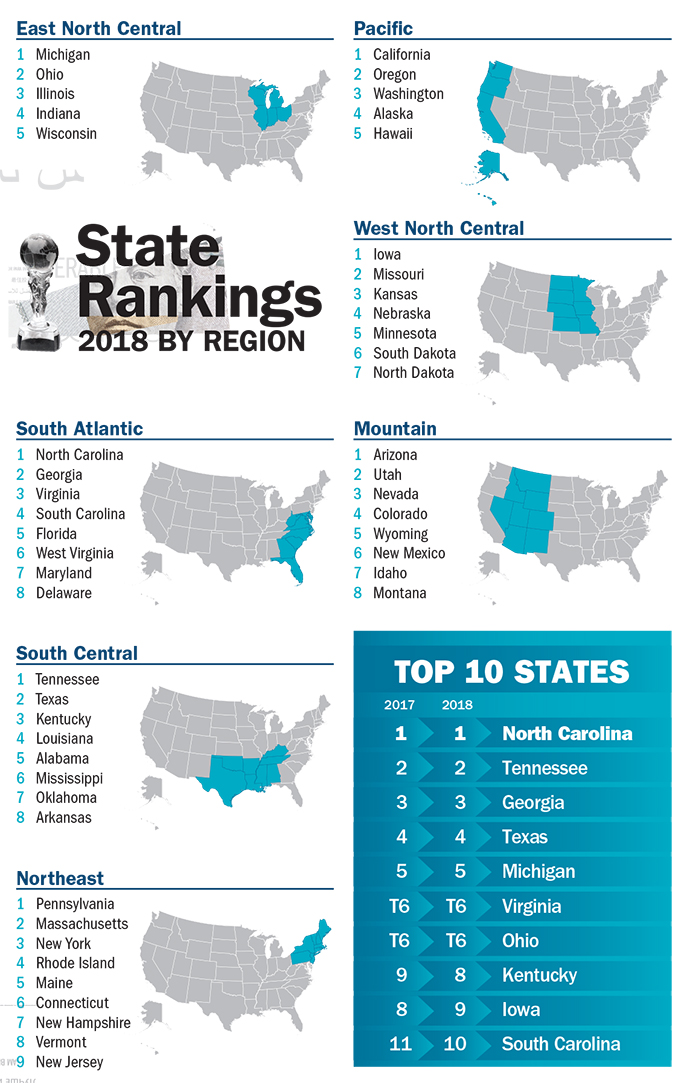It’s as if North Carolina’s short-lived HB2 experiment never happened. Remember the ill-fated, so-called bathroom bill that plagued its economic development prospects in 2016? We won’t rehash that here, but the point is it’s gone, and businesses big and small, domestic and foreign are investing in North Carolina for the same reasons they have been doing so all along — a healthy supply of workers despite very low unemployment, a favorable climate and location half-way along the East Coast, two international airports and industry sectors like IT, biotech and aerospace that are magnets for new investment.
“The fundamentals that have been drawing companies for a long time really haven’t changed much,” says Chris Chung, CEO of the Economic Development Partnership of North Carolina (EDPNC). “These include a great quality of life, well-renowned educational institutions and population growth with a lot of people coming out of school or mid-career who are moving here with a job or in search of one, all of which deepens the talent pool. We get a lot of in-migration from the Midwest and the Northeast.”
And North Carolina’s location in the Southeast doesn’t hurt. States in that region again have a grip on the top 10 most competitive states with just a handful outside the region — Michigan, Ohio and Iowa — making it into that tier (see the methodology on page 100). The Prosperity Cup for this year goes to the North Carolina Department of Commerce and EDPNC, the state-level agencies behind the Tar Heel State’s latest in a string of such wins.
Don’t write off the impact of its bathroom bill just yet.
“HB2 is a relevant piece of what we’re talking about — it’s not something we should not talk about,” says Secretary of Commerce Anthony Copeland. “March was the one-year anniversary of the repeal of HB2, and it was the 10-year anniversary of the bailout of Bear Stearns. Both of those are relevant because for the first three years of this century, North Carolina lost more manufacturing jobs than anyone. We made something of a recovery leading up to what everyone dealt with in 2008 — the Great Recession. Last year,” he continues, “one of the things Governor Cooper charged me with was bringing stability back to the economic development process — predictability and stability. For a time, there had been uncertainty around incentives, the Department of Commerce was restructured, and then we had HB2. Corporate America was uncertain about which North Carolina it was dealing with. So the goal was to bring stability back to the process. Working with members on both sides of the aisle, we have achieved that, with the governor’s leadership.”

“One of the things Governor Cooper charged me with was bringing stability back to the economic development process — predictability and stability.”
In a sense, HB2 was a catalyst in getting North Carolina back to where it had been. Having it and then removing it once a new governor and economic development chief were in place sent a strong message to the business world that it was still very much open for business and investment. And that it intended to reclaim its mantle as the location in the South that would lead the way as it had since the Research Triangle Park was established, the tech industry (IBM, SAS and many others) set its early and deep roots and state higher education came into a class of its own.
What Companies Want
Fast forward to 2018, and the Department of Commerce is responsible for 22,000 jobs for the first time since 2006, says Copeland. Why? Because predictability is being restored to North Carolina’s business climate, for one.
“Having been in business myself and executing a business plan, I know that businesses want to take all the uncertainty they can out of the [capital investment] process,” he says. “A company moving, relocating or expanding wants to eliminate risk factors. They want to know the workforce is there, the Department of Transportation and other agencies will be partners in the process, but in particular the incentives. If you’re negotiating those and tax credits, and they change — well you’ve lost all that momentum, and that’s money.”
Three common denominators emerge in virtually every discussion the secretary has with potential investors in North Carolina.
“Workforce is the first,” he relates. “Second is whether members of both sides of the aisle and the governor’s office will work together to help them move, whether with new legislation or other measures. We’ve satisfied all that. Another is the statutory incentives already in place. Will they receive in the future what was promised, and they are comfortable with that. We have been able to do that since the beginning of last year.”
“Talent is always at the top of the list,” Chung of EDPNC concurs, “even more so in a strong economy with a tight labor market. They want to know where it’s coming from, what sort of partnerships can they forge with the universities and the community colleges and perhaps how they can reach down into high schools or earlier than that to start getting people on track for that industry.”
They also need space to do what they do.
“There is almost always a real estate component to their site selection decision,” says Chung. “We tell our partners they have to have an available product. You can have a great business climate, a great workforce and a great location, but if you have nowhere to put a prospect in terms of developable sites or existing, modern buildings, then that can be a disqualifier by the time they start engaging the economic development community.”

As for the workforce, says Copeland, “With the exception of a few pockets in rural parts of the state, we’re basically at full employment – 4 to 4.5 percent. Parts of the state, like the Triangle and Charlotte, are destinations for employees. It’s not a problem recruiting people from around the world to come here. Infosys is putting 2,000 people here in Raleigh. Workforce continues to be our emphasis and continues to be the governor’s focus. We can’t stop doing that.”
Nor can it stop pushing the innovation envelope, which goes for businesses and government alike, if it is to remain a destination for global capital investment. Like most areas, North Carolina businesses must intensify their research and development efforts and the state must grow the share of community college and university students that earn degrees in science and engineering, according to the 2017 Tracking Innovation report released in December 2017 by the North Carolina Board of Science, Technology & Innovation. The report, the sixth in a series first published in 2000, rigorously evaluates the state’s standing against other states in the country on measures of innovation capacity and outlines ways to advance the state’s economy by encouraging and harnessing innovation.
Room for Improvement
“North Carolina has been home to many firsts, from the Wright Brothers’ first flight to the invention of the barcode” said Secretary Copeland at the time. “This report offers suggestions for how to develop and encourage the next generation of innovators in our state, the people who will create North Carolina’s next firsts.”
The North Carolina Innovation Index 2017 assesses the state’s performance across 40 measures of innovation-related assets, activities and trends. The strongest source of innovation remains North Carolina’s universities, according to the report. The state performs at 151 percent of the national average on the measure of appropriations for higher education expenses as a portion of gross domestic product (GDP), earning a 4th place ranking among the 50 states. High-tech business formation outpaced the national average by 23 percentage points. North Carolina manufacturing output as a function of total GDP ranks 4th in the country, performing at 164 percent of the U.S. average.
The report does identify areas for improvement, noting the state’s share of engineers as a percentage of all workers ranks 33rd in the U.S. In terms of R&D activities performed by business, the state performed at only 91 percent of the national average for a 21st place ranking, although this performance did mark an improvement from the 2015 report.
“North Carolina is known for encouraging innovation, but our well-deserved high-tech reputation sometimes masks the work that remains for us to do,” said Dr. John Hardin, executive director of the North Carolina Office of Science, Technology & Innovation, a unit of N.C. Commerce. “This report offers elected officials, policymakers, economic development professionals, educators and business leaders several tangible suggestions for further developing an innovation-oriented economy in North Carolina.”
The takeaways are not as surprising as one may think, Secretary Copeland tells Site Selection. “It’s an educated workforce, access to universities. Most of our large investment is coming within 60 miles of a university. North Carolina has 16 public ones around the state, not to mention the private ones. Just in the Triangle area, there are 40,000 graduates each year. There’s a biotech cluster, an IT cluster. Innovation will necessarily grow in places where there is private capital driving it.”
Proximity to density, says Chung, comes up more frequently in discussions with investors, particularly office and technology prospects. “It’s no longer the suburban campus — they are gravitating more to something closer to the urban core in whichever market they’re interested in. They believe that’s what millennials want — a situation where they can live work and play all within a few blocks — and that it will make them more successful in attracting talent.”
The state’s vast and well-regarded community college system is a huge source of talent and in some ways a more malleable one, given the agility they have to meet specific company worker requirements.
“We have 58 campuses in our community college system — Wake Tech alone in Wake County has 70,000 students. That is a huge pipeline for secondary education. We’re working with the community colleges on registered apprentice programs, which are supported and funded by the state,” Copeland illustrates. “We will continue to work with them to be more innovative and help streamline the bureaucracy associated with using them. Another level is not-registered apprentice programs that companies are doing themselves. A lot of those programs are based on the German apprenticeship model.”
The World Comes to Work
That will more effectively supply German companies with the right labor going forward, but foreign direct investment from many markets is happening at a very brisk pace, including in rural North Carolina. Chinese tire manufacturing company Triangle Tyre (Triangle), for example, has selected Edgecombe County as the location for its first manufacturing facility in the United States. It will create 800 jobs and invest nearly $580 million in Kingsboro. The two-phase project is estimated to contribute more than $2.4 billion to North Carolina’s economy.
The company expects to complete both phases by 2023. Once both facilities reach production capacity, Triangle expects to produce six million tires annually. Salaries for the new positions will vary, with an average annual salary of $56,450 once all positions are filled. The average wage in Edgecombe County is $32,642.
Triangle’s development in Edgecombe County will be facilitated, in part, by a Job Development Investment Grant (JDIG) approved by the state legislature’s Economic Investment Committee. Over the course of the 12-year term of this grant, the project will grow the state’s economy by an estimated $2.4 billion. Using a formula that takes into account the new tax revenues generated by the new jobs, the JDIG agreement authorizes the potential reimbursement to the company of up to $20.1 million, spread over 12 years. State payments only occur following performance verification by the N.C. departments of Commerce and Revenue that the company has met its incremental job creation and investment targets. JDIG projects result in positive net tax revenue to the state treasury, even after taking into consideration the grant’s reimbursement payments to a given company.
“We’re getting Israeli companies, Japanese companies — we’re part of the global marketplace,” says Copeland. “North Carolina is the ninth most populous state in the country now, and we have an economy larger than Sweden. Credit Suisse was the first big project after HB2 was lifted last year. It has been one after another of international projects, and it’s pushing North Carolina forward.”
FDI Project Will Boost Local Economy
EGGER Wood Products, one of Europe’s leading wood-based materials suppliers for the furniture, wood construction and flooring industries, has selected Lexington, in Davidson County, as the location for the company’s first U.S. manufacturing plant. Its development plans include creating 770 jobs over the next 15 years with a proposed $700 million investment. The first phase, creating 400 jobs, will happen over the next six years, and an additional 370 jobs are planned for later phases of the project.
A family-owned company based in Tyrol, Austria, EGGER Group operates 17 plants and 25 sales offices worldwide, providing a wide range of wood-based products. EGGER is the global leader in decorative surfaces on wood-based materials and has developed a complete range of products and cutting-edge designs. The facility in North Carolina will be a state-of the-art particleboard manufacturing plant and will contribute to the regional economy by purchasing wood byproducts from sawmills and working with a range of local suppliers for additional services.

“You can have a great business climate, a great workforce and a great location, but if you have nowhere to put a prospect in terms of sites or buildings, then that can be a disqualifier by the time they start engaging the economic development community.”
The North Carolina Department of Commerce and the Economic Development Partnership of N.C. (EDPNC) led the state’s support for the company’s decision. EGGER will bring a variety of advanced manufacturing jobs to North Carolina including management, administration and skilled production workers. Average salaries for the new jobs are expected to be $40,000, above Davidson County’s current average annual wage of $36,836.
EGGER’s expansion in Davidson County will be facilitated, in part, by a Job Development Investment Grant (JDIG) approved by the state’s Economic Investment Committee. Over the course of the 12-year term of this grant, the project will grow the state’s economy by an estimated $1 billion. Using a formula that takes into account the new tax revenues generated by the new jobs, the JDIG agreement authorizes the potential reimbursement to the company of up to $5.3 million, spread over 12 years.
The project was also made possible by a performance-based grant from the One North Carolina fund of up to $2.5 million. The One NC Fund provides financial assistance, through local governments, to attract business projects that will stimulate economic activity and create new jobs.
What else can North Carolina bring to the table to ensure competitiveness going forward?
Besides an engaged university and community college network with customized training for industry, “You need a good K to 12 system, and policy makers here are figuring out how to make sure they have the resources for students so they exceed in higher education or in the workplace,” says Chris Chung. “It’s making sure North Carolina continues to be diverse and welcoming to all the in-migration coming into the state for its quality of life and economic opportunity. Those feed into our talent value proposition. As people move here, it deepens the talent pool for those. That makes North Carolina more attractive as a place to move to. That means we all keep our foot on the pedal with respect to the workforce we can offer.”

